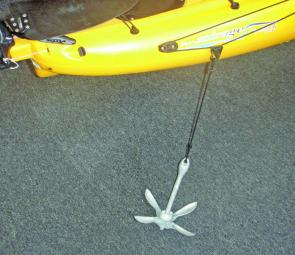Fishing while at anchor from a kayak can be happy an experience.
However if it isn’t well set up then it can become clumsy and ultimately annoying.
The main problem with kayaks at anchor is that you can’t turn your seat around, so if anchored from the bow the angler ends up fishing backwards as current and wind drag your lines behind you.
I also find carrying too much gear involved with anchoring affects space and extra anchor line lying around the cockpit is also untidy.
The solution to some of these problems is a simple system called an anchor trolley. It basically consists of a pair of pulleys, some line, a snap shackle and some rope guides.
The idea is that a loop of line is run through the pulleys mounted on the bow and stern of the kayak.
Some people add a small length of bungee cord to part of the rope loop to act as a shock absorber. Tied to one side of the loop is the snap shackle, which is then free to run up and down the length of the kayak from one end to the other.
I tie a loop knot in the boat end of my anchor line and simply clip it to the snap shackle. This allows me to swivel the kayak around on the end of the anchor line so that it can face forwards like a normal boat at anchor, sideways, or my favourite, which is backwards.
In this position I can fish at anchor with my lines dragging out in front of me and unless there is a strong tide, usually with the wind at my back. The anchor trolley system also makes retrieval a lot easier as the anchor line can be brought to the middle of the kayak instead of having to go forward for it.
You can source the parts at a local bolt shop to install this setup, but I use a Hobie brand Anchor Trolley Kit as it comes with lots of useful bits for all sorts of kayaks and some really tidy side mounted pulleys called cheek blocks.
They bolt neatly to the side of the kayak without the need to use saddles and shackles to fix the pulleys to each end. I also mount each pulley to the side and slightly back from the bow or stern of each end so that the loop of line tends to stay out of the cockpit.
Run some cord through the pulleys and tie each end to the snap shackle while removing the slack and trimming it off. One side of the cord loop can be pinned down by using some guides mounted down the side of the kayak while the other side with the snap shackle needs to be allowed to run free from one end to the next.
I use stainless steel threaded screws backed with wide washers and nylock nuts for all the fittings installed.
I use a 1.5kg folding anchor for the job. There are plenty of anchor styles to choose from so use what suits your area best; just keep it as small as possible so it is easier to store.
If you intend to anchor in a place with lots of current then rather than use a bigger anchor try adding plenty of chain instead. It helps the anchor stay pointed down and gripping the bottom.
Anchor line or cord doesn’t need to be thick to have great strength. I use 4mm braided nylon line as a long bundle takes up little room and it’s more than strong enough to take the load. I hate any loose cord in the cockpit so rather than tying off the anchor at the kayak to adjust it, I carry pre set lengths that suit the depth I know I am going to fish in.
If I need more I just keep a few more lengths with a loop tied at one end and a snap shackle on the other. They act as extensions that can be clipped on quickly as needed. It also pays to add a small visible float to the end of your anchor line. That way you can quickly unclip and chase down a big fish if something is intent on heading for the horizon.
Another good way of anchoring up if fishing shallow waters is to use a stakeout pole. It’s basically a long sturdy pole that is pointed at one end and at the other has a short length of line with a loop at the end.
It is simply driven into the bottom and clipped to the kayak using the anchor trolley system. It’s quick and neat to use and great for bream tournaments.
My stakeout pole is even more efficient and can actually can be driven through the kayak’s scupper hole moulded into the cockpit. My Pro Angler ends up looking like a giant hors d’oeuvres, speared with a cocktail toothpick to the bottom but it doesn’t get any neater or faster to use.
Reads: 4990
Anchor set-up on an Hobie anchor trolley system




